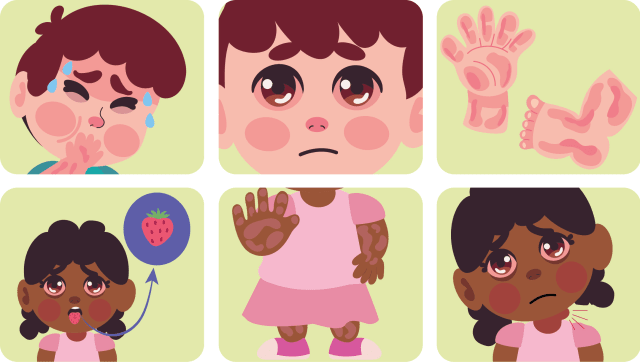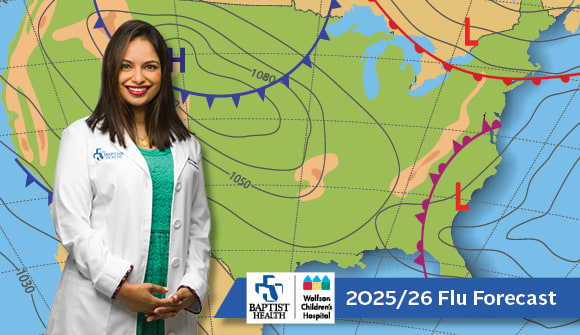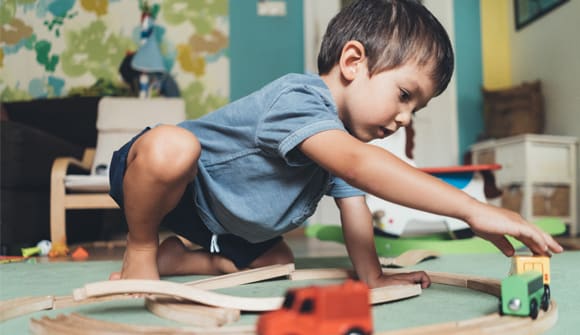Could it be Kawasaki?
Symptoms mirror more common conditions.
Article Author: Juliette Allen
Article Date:

Any parent can tell you that little kids get sick – a lot. Though fevers and rashes may seem a dime a dozen, there are times these symptoms warrant a closer look. In fact, those are two of the common symptoms of a serious condition that, though rare, is on the rise: Kawasaki disease.
“Kawasaki is an illness that affects multiple systems in the body and causes inflammation in the blood vessels,” explained Kumar Ponniah, MD, a pediatric cardiologist with the Wolfson Children’s C. Herman and Mary Virginia Terry Heart Institute. “It’s the leading cause of acquired [developed during childhood] heart disease in the United States.”
Symptoms of Kawasaki
According to Dr. Ponniah, Kawasaki disease is most commonly diagnosed in children under 5, though it can affect older children, as well. Symptoms include:
- Fever
- Dry or cracked lips
- Redness of the eyes and tongue
- Skin rash
- Swelling of the hands, feet and/or lymph nodes in the neck
If left untreated, Kawasaki disease can cause dilation (enlargement) and swelling of the arteries (aneurysms) in about 25% of children, Dr. Ponniah said.
“Individually, these symptoms may seem relatively innocuous, but if your child develops an unexplained fever that lasts more than four or five days along with any of the other signs, you should contact your child’s pediatrician and keep Kawasaki in mind. Since there’s no single test for this condition, the pediatrician may order additional bloodwork or an echocardiogram [heart ultrasound] to investigate further.”
Post-pandemic diagnosis rise
Kawasaki disease is rare, only affecting 9 to 20 per 100,000 children under 5, according to the Centers for Disease Control and Prevention. However, doctors have noticed a rise in diagnoses in the years following the COVID-19 pandemic.
Viral infections or currently unknown agents entering through the lungs are believed to be possible triggers.
“During the pandemic, the incidence of Kawasaki came down by about a third,” Dr. Ponniah explained. “It’s believed that our preventive measures, including masking, hand washing, school closures and social distancing, prevented the spread of illnesses that may have led to Kawasaki, especially in children older than 2. However, once people started gathering and viruses started circulating again, we started to see Kawasaki diagnoses climb because more people were getting sick.”
Curing Kawasaki
According to Dr. Ponniah, there is a highly effective treatment and most children will recover from Kawasaki disease without any long-term effects. Severe cases or those left untreated may develop potentially dangerous complications and need to be monitored long term by a pediatric cardiologist.
Some children who recover from Kawasaki may be at risk for heart disease later in life, which means prioritizing a well-balanced diet, exercise and other healthy lifestyle habits.
“Kawasaki disease is a serious condition, and one we want parents to keep in mind if their child is showing symptoms, but we certainly don’t want people to panic,” Dr. Ponniah said. “Just be vigilant and talk to your child’s pediatrician if you have concerns.”
The pediatric cardiovascular specialists with Wolfson Children’s Terry Heart Institute treat a full range of heart conditions, from defects present at birth to conditions acquired during childhood. To learn more, visit wolfsonchildrens.com/heart or call 904.202.8550.
Reference: Centers for Disease Control and Prevention



